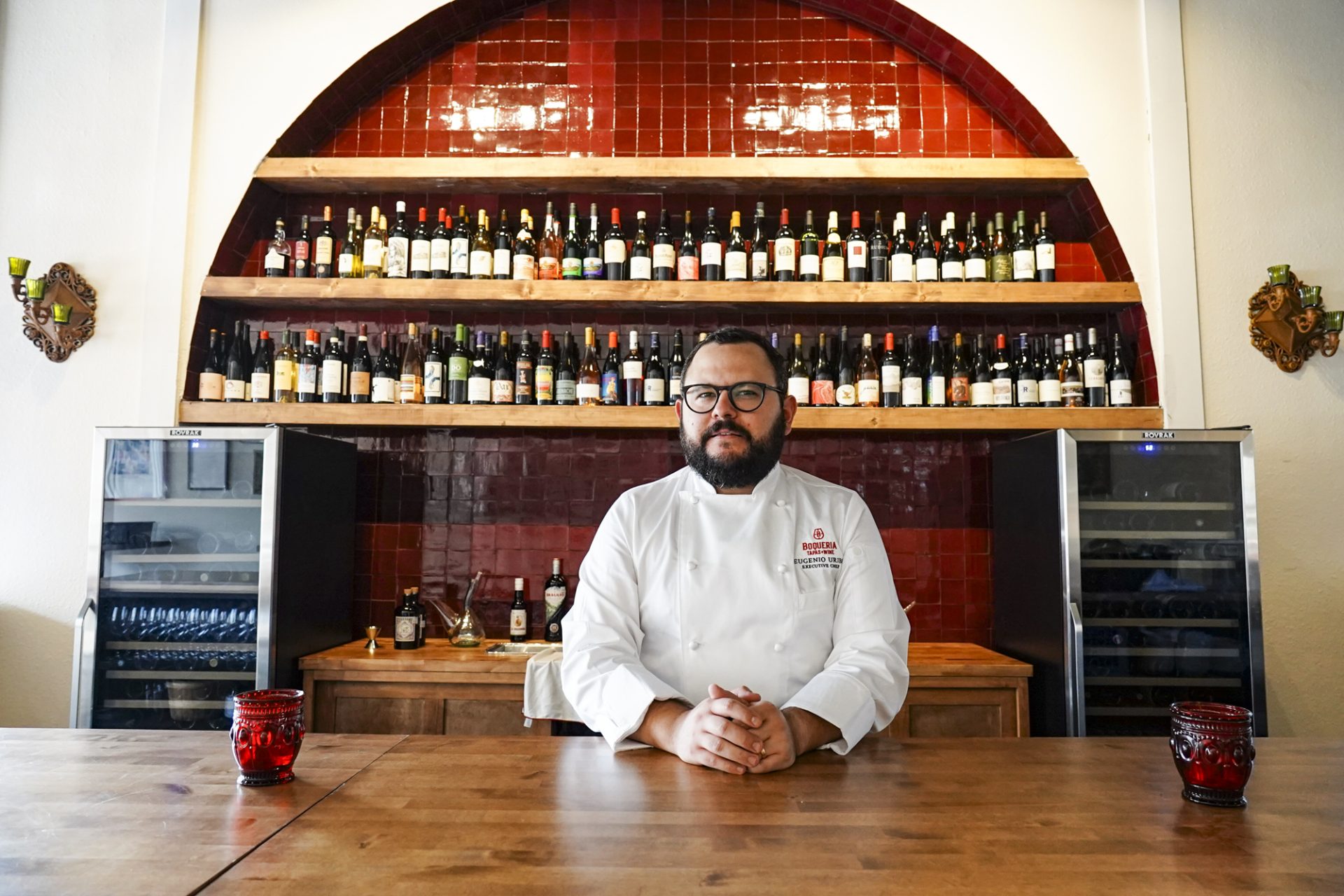A group of Brownsville area students got a history lesson like no other when they were invited to take part in the filming of a documentary based on the book “Stitched & Sewn: The Life-Saving Art of Holocaust Survivor Trudie Strobel” by Jody Savin.
More than a dozen high school students gathered at the Brownsville/George Ramirez Performing Arts Academy on Nov. 7 to take turns reading passages of the book while the camera rolled. Savin, in a phone interview with The Brownsville Herald, said shooting for the documentary is also taking place in Los Angeles, where Savin is based, Ohio and New York.
Strobel, born in 1938 in present-day Ukraine and now a California resident, was 4 years old when she and her mother were forced from their home by the Nazis, jammed into a cattle car for a 600-miles trip to the notorious Lodz Ghetto in German-occupied Poland. There they were confined before being transferred to a labor camp. She and her mother, Masha, had sewing skills, which allowed them to survive, forced to stitch clothes for Hitler’s army.
Years after being freed by American soldiers in 1945 after Germany’s surrender, Strobel and her mother finally realized their dream of coming to the United States, first settling in Chicago and later California. Trudie married and had two sons. She never talked about the horror during her childhood. In her 50s, however, with Strobel’s sons grown and out of the house, the memories came flooding back, pushing her into a catatonic state of depression.
Strobel could not talk, so a therapist suggested she trying drawing to express what she was feeling. She first picked up a pencil, and then a needle and thread. It was the first step toward the creation of a series of breathtaking tapestries Strobel would hand-stitch over decades, telling the story of her time at the hands of the Nazis.
Among the many heart-wrenching, stitched images she would go on to create is on based on her memory of a Nazi SS officer ripping a beloved doll from her arms (a gift from her father, killed for being Jewish by Stalin’s regime before the war). Tears run down her cheeks as her mother begs her not to cry, so as not to draw attention. In the background of the finely detailed scene, Jewish men, women and children are loaded onto cattle cars by soldiers at gunpoint. The tapestry, titled “Russia 1942,” is bordered by 26 Stars of David joined together with barbed wire.
Telling her story this way, one painful stitch at a time, succeeded in lifting Strobel out of her depression.
“They needed a window into what was going on, and she picked up a needle and thread and began to stitch,” Savin said. “And stitching is what saved her and her mother from the Nazis. So it was like this divine circling back to what saved her in childhood, then saved her again from depression. It’s an incredible story.”
Savin first met Strobel through her daughter, Maya Savin Miller, who was studying for her bat mitzvah and was referred to Strobel for her Torah project — part of the preparation Jewish 12- or 13-year-olds undertake in advance of their mitzvahs. Maya’s project involved remembrance, and she had arranged to interview Strobel about a fellow Holocaust survivor, who had recently died and whose memory Strobel was carrying, a man whose young daughter was murdered in front of him at the Auschwitz death camp.
Savin said she drove her daughter to Strobel’s modest home in San Marino, Calififornia, and was astounded by what she saw.
 Shown is a tapestry created by Holocaust survivor Trudie Strobel, whose childhood experiences under the Nazis form the basis for the book “Stitched & Sewn: The Life-Saving Art of Holocaust Survivor Trudie Strobel,” also the subject of a documentary. (Courtesy: Jody Savin)
Shown is a tapestry created by Holocaust survivor Trudie Strobel, whose childhood experiences under the Nazis form the basis for the book “Stitched & Sewn: The Life-Saving Art of Holocaust Survivor Trudie Strobel,” also the subject of a documentary. (Courtesy: Jody Savin)“There in her house was this vast collection of huge tapestries that are done thread by thread.,” Savin said. “Embroidery thread has six strands. She disassembles the thread, so it’s thread-by-thread, so that she can stitch your portrait in thread. They’re huge. And she’s been stitching for decades alone in her house, the history of what she experienced as a prisoner of the Nazis as a child.”
Strobel recently completed what she considers the coda, or conclusion, to her Holocaust series, though she never really stops, Savin said.
“She’s always, ‘That’s it,’ and then she always begins again,” Savin said. “Then she started stitching the history of the Jewish people, the culture, the lore. She just started becoming like a researcher and a documenter in thread. We were just like gobsmacked. It was crazy.”
Strobel bonded with Maya, who mounted a major exhibition of Strobel’s tapestries with the help of a partner and a $5,000 grant. A series of dolls Strobel had made representing 11 centuries of Jewish degradation had long been featured at Holocaust Museum LA (formerly the Los Angeles Museum of the Holocaust), but her tapestries had never been seen by the public.
The exhibition, which was a hit, went on the road, Maya doing her best to manage it while attending high school, though she wanted to extend Strobel’s reach even more.
“She said, ‘Mom, someone has to write the book. I don’t have time,’” Savin recalled. “I’m a screenwriter, so I’d never written a book.”
But she said yes, landing a grant from the Memorial Foundation for Jewish Culture to help cover travel to see various works Strobel had given away over the years. “Stitched & Sewn,” filled with beautifully shot photographs of Strobel’s work, was published in 2020. Then COVID hit, and Maya’s traveling exhibition went into storage for over a year.
Strobel, Savin and her daughter have traveled all around give talks to students and adults about empathy and tolerance education, which is at the heart of Strobel’s mission, Savin said. However, touring has become much harder for Strobel, now in her mid-80s, not to mention that “revisiting that trauma on a regular basis is just so debilitating,” Savin said.
CBS Morning did lengthy piece on Strobel to coincide with the 70th anniversary of D-Day on June 6, which caused “Stitched & Sewn” to sell out, prompting a second edition, Savin said. Still, to get Strobel’s story out to more people, she and her husband, both filmmakers, decided to make a documentary, and received a second grant from the Memorial Foundation to help do so, though more funding is needed, Savin said.
“The fundraising process is very difficult on a documentary, but we’re doing it anyway because it needs to be done,” she said.
 Author and filmmaker from Pasadena, California Jody Savin holds a copy of her book “Stitched & Sewn: The Life-Saving Art of Holocaust Survivor Trudie Strobel” on Thursday, Nov. 7, 2024. (Miguel Roberts | The Brownsville Herald)
Author and filmmaker from Pasadena, California Jody Savin holds a copy of her book “Stitched & Sewn: The Life-Saving Art of Holocaust Survivor Trudie Strobel” on Thursday, Nov. 7, 2024. (Miguel Roberts | The Brownsville Herald)As for how Brownsville fits in, Savin is friends with Rita Hernandez, executive director of the Cameron County Education Initiative and a local film producer. Savin, meanwhile, was already planning a Fort Worth trip to interview a U.S. Army veteran who helped liberate Hitler’s camps.
“We called Rita,” Savin said. “We said we’re coming to Texas. We’d like to pop down to Brownsville and have some of her students read from the book. Part of the spine of documentary is having people from all parts of the country, people from all walks of life. … She always tells us about Brownsville. It sounds so cool and it’s such a beautiful city.”
Hernandez said the Nov. 7 filming “went beautifully.”
“The kids, every single one of them, thanked them afterwards,” she said. “It was a perfect way to connect with history and a great opportunity for the students to be a part of this.”
Earlier in the day, the filmmakers shot a historical tour of the Historic Brownsville Hebrew Cemetery led by Larry Holtzman, who talked about the impact of Jewish families on Brownsville, Hernandez said, adding that Lay Rabbi Roland Barron also took part in the project.
Among the students who took part were those from Pace and Porter high schools, the National Hispanic Institute and Camille Playhouse, she said. Jeremiah Alba II, a ROCA Scholar, shadowed the filmmakers and helped organize the event, serving as assistant on the shoot, Hernandez said.
“The students were so happy to be a part of it,” she said. “They were able to connect to history more intimately. It was good for them. I told them, ‘Add it to your resume.’”
To find out how to buy “Stitched & Sewn: The Life-Saving Art of Holocaust Survivor Trudie Strobel,” go to trudiestrobel.com/stitched-sewn.
To help support the making of the documentary, go to trudiestrobel.com/documentary.
The post Brownsville students take part in Holocaust survivor project appeared first on MyRGV.com.
 (2).png)
 3 months ago
70
3 months ago
70







 English (US)
English (US)